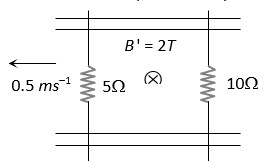Physics-
General
Easy
Question
A pair of parallel conducting rails lie at right angle to a uniform magnetic field of 2.0 T as shown in the fig. Two resistors 10  and 5
and 5  are to slide without friction along the rail. The distance between the conducting rails is 0.1 m. Then
are to slide without friction along the rail. The distance between the conducting rails is 0.1 m. Then

- Induced current
 directed clockwise if 10 W resistor is pulled to the right with speed 0.5 ms–1 and
directed clockwise if 10 W resistor is pulled to the right with speed 0.5 ms–1 and  resistor is held fixed
resistor is held fixed
- Induced current
 directed anti-clockwise if 10 W resistor is pulled to the right with speed 0.5 ms–1 and
directed anti-clockwise if 10 W resistor is pulled to the right with speed 0.5 ms–1 and  resistor is held fixed
resistor is held fixed
- Induced current
 directed clockwise if 5 W resistor is pulled to the left at 0.5 ms–1 and 10 W resistor is held at rest
directed clockwise if 5 W resistor is pulled to the left at 0.5 ms–1 and 10 W resistor is held at rest
- Induced current
 directed anti-clockwise if 5 W resistor is pulled to the left at 0.5 ms–1 and 10 W resistor is held at rest
directed anti-clockwise if 5 W resistor is pulled to the left at 0.5 ms–1 and 10 W resistor is held at rest
The correct answer is: Induced current  directed anti-clockwise if 5 W resistor is pulled to the left at 0.5 ms–1 and 10 W resistor is held at rest
directed anti-clockwise if 5 W resistor is pulled to the left at 0.5 ms–1 and 10 W resistor is held at rest
When  resistor is pulled left at 0.5 m/sec induced emf., in the said resistor =
resistor is pulled left at 0.5 m/sec induced emf., in the said resistor = 
Resistor  is at rest so induced emf in it
is at rest so induced emf in it  be zero.
be zero.

Now net emf.,
in the circuit 
and equivalent
resistance of the circuit
R = 15 W
Hence current 
And its direction will be anti-clockwise (according to Lenz’s law)
Related Questions to study
physics-
Two coils P and Q are placed co-axially and carry current I and I' respectively

Two coils P and Q are placed co-axially and carry current I and I' respectively

physics-General
physics-
An alternating voltage of 141.4V (rms) is applied to a vacuum diode as shown in the figure. The maximum potential difference across the condenser will be

An alternating voltage of 141.4V (rms) is applied to a vacuum diode as shown in the figure. The maximum potential difference across the condenser will be

physics-General
physics-
The diagram of a logic circuit is given below. The output F of the circuit is represented by

The diagram of a logic circuit is given below. The output F of the circuit is represented by

physics-General
physics-
The shows two NAND gates followed by a NOR gate. The system is equivalent to the following logic gate

The shows two NAND gates followed by a NOR gate. The system is equivalent to the following logic gate

physics-General
physics-
The combination of gates shown below produces

The combination of gates shown below produces

physics-General
physics-
Figure gives a system of logic gates. From the study of truth table it can be found that to produce a high output (1) at R, we must have

Figure gives a system of logic gates. From the study of truth table it can be found that to produce a high output (1) at R, we must have

physics-General
physics-
The following configuration of gate is equivalent to

The following configuration of gate is equivalent to

physics-General
physics-
For the transistor circuit shown below, if , voltage drop between emitter and base is 0.7 V then value of will be

For the transistor circuit shown below, if , voltage drop between emitter and base is 0.7 V then value of will be

physics-General
physics-
In the following circuit find and

In the following circuit find and

physics-General
physics-
In the circuit shown in figure the maximum output voltage  is
is

In the circuit shown in figure the maximum output voltage  is
is

physics-General
physics-
Ge and Si diodes conduct at 0.3 V and 0.7 V respectively. In the following figure if Ge diode connection are reversed, the valve of V0 changes by

Ge and Si diodes conduct at 0.3 V and 0.7 V respectively. In the following figure if Ge diode connection are reversed, the valve of V0 changes by

physics-General
physics-
A diode is connected to 220 V (rms) ac in series with a capacitor as shown in figure. The voltage across the capacitor is

A diode is connected to 220 V (rms) ac in series with a capacitor as shown in figure. The voltage across the capacitor is

physics-General
physics-
In which of the following circuit is the current maximum just after the switch S is closed

In which of the following circuit is the current maximum just after the switch S is closed

physics-General
maths-
Range of function f(x) =  is given by
is given by
Range of function f(x) =  is given by
is given by
maths-General
physics-
Find VAB

Find VAB

physics-General





